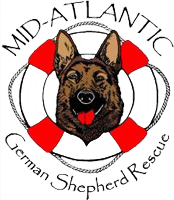CLICK HERE FOR INFORMATION ON COMMON HEALTH PROBLEMS FOR SHEPHERDS
Animal CPR: How To Save Your Dogs Life
Save a Life: Learn Animal CPR
For the EMS Provider and Pet Owner
Lori H. Feldman, DVM
Henry J. Feldman, MA EMT-M
(c) 1996Dr. Feldman is a Massachusetts and New York Licensed Veterinarian and a member of the Veterinary Emergency and Critical Care Society. This document is primarily aimed at EMS and Emergency Medical personnel who may encounter animals in arrest.
Pet owners should consult their veterinarian for specific details on procedures outlined here.
web: http://members.aol.com/henryhbk
email: henryhbk@aol.com
A. Airway
The first step in animal CPR, after determining non-responsiveness, is to obtain a patent airway. You should not continue on, until this step has been achieved.
Carefully pull the tongue out of the animal's mouth
WARNING: even an unresponsive dog may bite by instinct!!Make sure that the neck is reasonably straight; try to bring the head in-line with the neck.
WARNING: Do not hyperextend in cases where neck trauma existsAttempt 2 rescue breaths, by closing the mouth, and performing mouth-to-nose ventilations. If they go in with no problems continue to B-Breathing.
Reposition the neck and try step 3 again.
Visibly inspect the airway by looking into the mouth, and down the throat for foreign objects occluding the airway. Unlike human-CPR, rescuers may reach into the airway and remove foreign objects that are visible
Proceed to the Heimlich maneuver
A. Heimlich
After attempting to ventilate:
Turn the animal upside down, with its back against your chest
With both arms, give 5 sharp thrusts (bear hugs) to the abdomen. Perform each thrust as if it is the one that will expel the object
Stop, check to see if the object is visible in the airway, if so, remove it and give 2 mouth-nose rescue breaths. If the breaths do not go in, go back to step 1
Use gravity to help you expel the object
Do not proceed with CPR, even if the animal goes into cardiac arrest. You must clear the airway first.
B. Breathing
After achieving a patent airway, one must determine whether the animal is breathing, and whether this breathing is effective:
Carefully pull the tongue out of the animal's mouth
WARNING: even an unresponsive dog may bite by instinct!!Make sure that the neck is reasonably straight; try to bring the head in-line with the neck.
WARNING: Do not hyperextend in cases where neck trauma existsVentilate the animal by closing the mouth, and performing mouth-to-nose ventilations. If they do not go in with ease go to A-Airway
Ventilate at 20 breaths per minute If supplemental Oxygen is available, and the animal is breathing on its own, use a high-flow blowby.
WARNING: Do not attempt to intubate the animal, without prior training, and properly sized ET tubes.Proceed to C-Circulation, while continuing respiratory support as necessary
C. Circulation
This is the final step of CPR and should only be initiated after the airway and breathing steps have been completed:
- Make sure that there are no major (pooling/spurting blood) points of bleeding. Control as necessary
- Lay the animal on its right side
- Locate your hands where its left elbow touches the chest. Approximately the middle of the rib-cage
- Compress the chest 15 times followed by 2 rescue breaths (3 compressions every 2 seconds)
Compress
- 1/2" - small dogs
- 1" - medium dogs <
- 1.5" - large dogs
- Repeat as necessary
Important: Animals do not have palpable carotid pulses. You can only obtain a femoral pulse in the inguinal crease. (Palpate carefully on a conscious dog!)
E. Extra
During an emergency it is very important that you remain calm. Animals can sense your unease, but cannot understand what is happening and you cannot verbally tell them. Your body language is very important. Be calm, yet deliberate in your actions.
When you determine that you either have corrected the life-threatening problem, or are unable to stabilize the animal, you should transport to the nearest emergency veterinary hospital.
Notify your emergency clinic that you are coming in with a dog in respiratory arrest with a foreign body airway obstruction and/or cardiac arrest.
Give them the following information via phone if possible:
- Your name
- Your ETA
- Steps taken (CPR, O2...)
- Breed/size
- If a foreign body, what the suspected object is
- If a poison or medication has been ingested
- Mechanism of injury (hit by car...)
Download Adobe Acrobat Version Here
CLICK HERE FOR INFORMATION ON COMMON HEALTH PROBLEMS FOR SHEPHERDS

